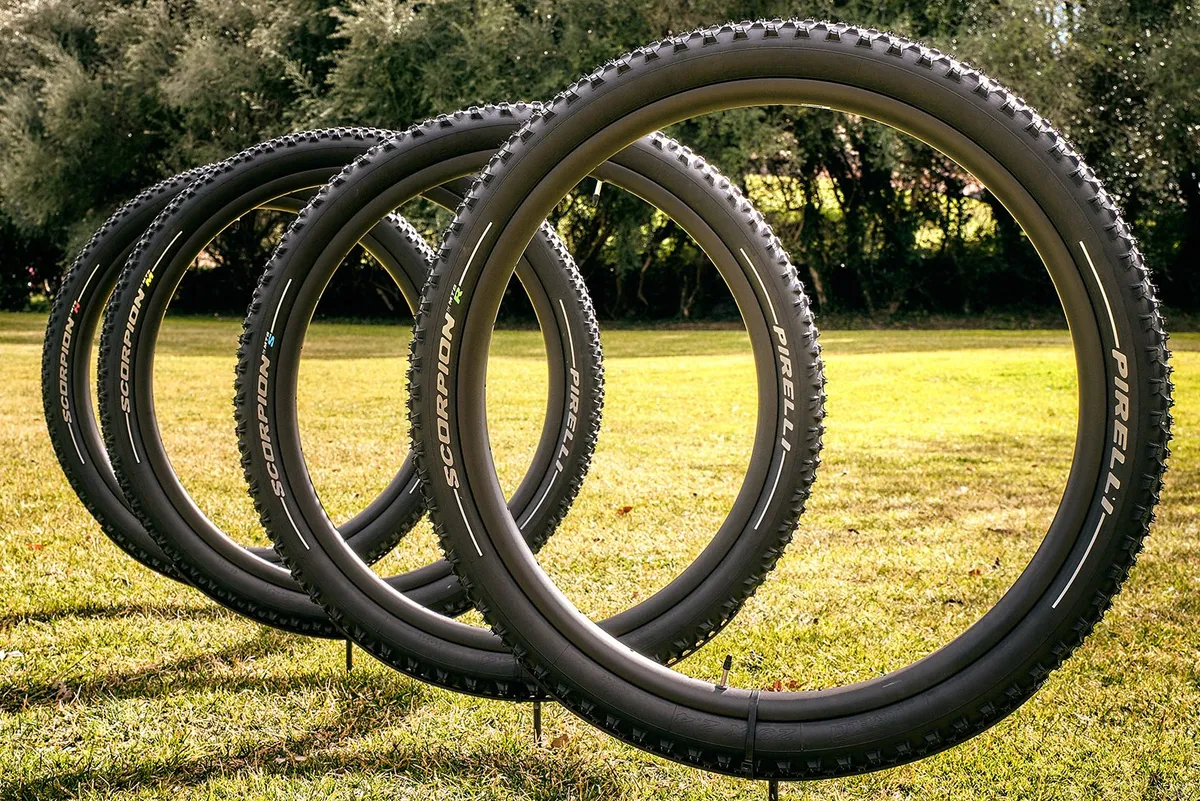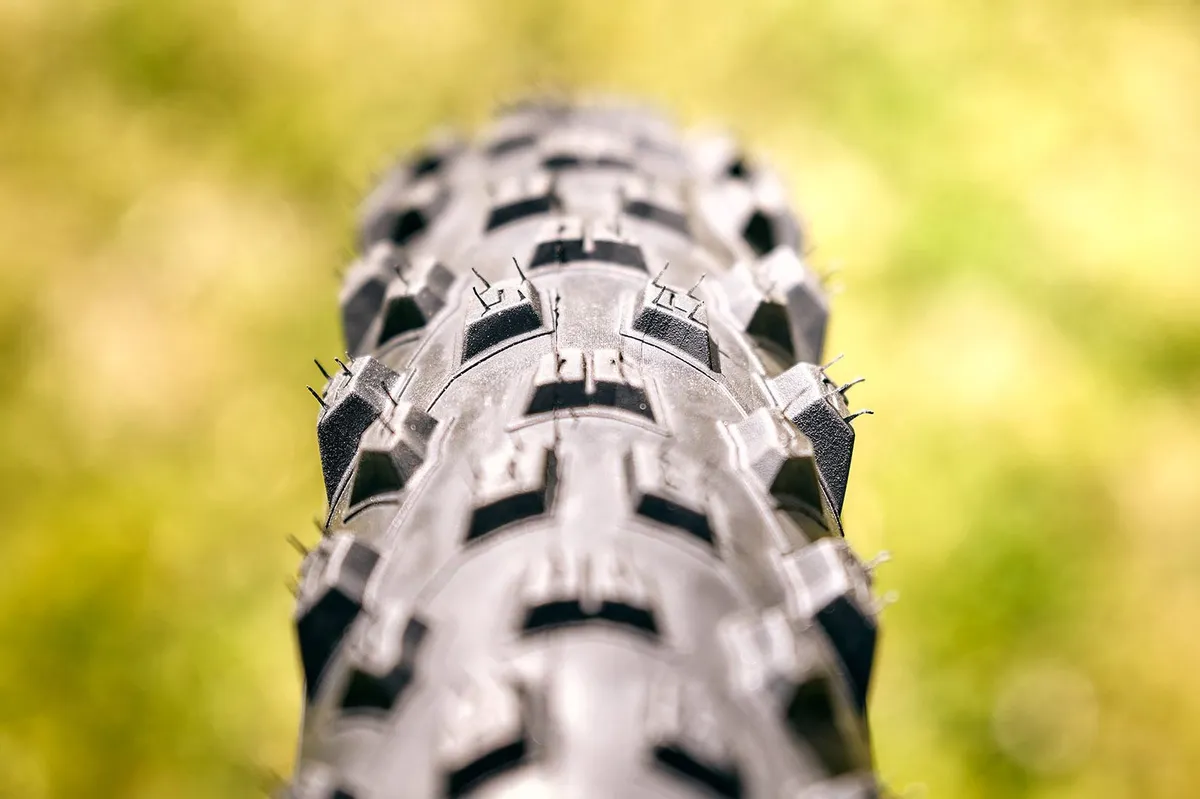As one of the most iconic performance tyre manufacturers on the planet, with a history in racing and competition that dates back to 1872, it’s relatively surprising that it has taken this long for Pirelli to venture into the off-road MTB market.
- What’s the fastest tyre size for mountain biking?
- Top-spec vs value tyre compounds: is there any difference?
- MX meets MTB with the Schwalbe Eddy Current e-MTB tyre
Following the arrival of its PZero Velo road bike tyre in 2017, we’ve had to wait two whole years before hearing news about what the Italian’s have been up to for us mud-loving mountain bikers.
Alex talks us through Pirelli's all-new MTB tyres on our YouTube channel
Pirelli Scorpion MTB tyre overview and details

The Scorpion name is synonymous with performance in the automotive and moto world, and Pirelli is hoping that this reputation will transfer over with the launch of its MTB range.
At the heart of the range is Pirelli’s desire to redefine and simplify the consumer’s experience when trying to buy tyres.
We currently choose tyres for our bikes depending on the weather conditions or style of riding we’re going to be doing. For example, there are mud tyres suitable for DH, mud tyres that are suitable for cross-country, dry weather tyres for the same and everything in between — the list goes on.

Pirelli argues that this means the consumer needs to have an inherent knowledge of the types of applications suited to specific tyres before purchasing.
So, in a bid to simplify the purchasing process Pirelli is launching four tyres: the Scorpion H for hardpack terrain, the Scorpion M for mixed terrain (both soft and hard ground), the Scorpion S for soft terrain and the Scorpion R that’s a rear-biased tyre.
Pirelli is claiming that its tyres perform just as well in both dry and wet conditions as long as you’re on the correct tyre for the terrain type.
Sounds simple, right? Well, kind of. Read on.
Pirelli Scorpion MTB tyre development

Pirelli was very keen to talk about its development and testing process — something it's proud of and makes up the foundations of all its products.
It claimed that it's had 140 different tyre prototypes, ridden over 30,000km on the tyres and climbed and descended 95,000m. Eight dedicated testers and plenty of other people have been riding them too.
The tyres were tested blind, as well. Engineers made changes to the tread patterns and compounds without telling the testers about the changes. The testers would then feedback to the engineers on how the tyres felt and the engineers then compared the tester's feelings to quantified changes.
Pirelli’s testing experience obviously works if you take one look at its track record for car and motorbike tyres, but will its rigorous methodology translate to the dynamic and variable-laden world of MTB?
Pirelli Scorpion MTB tyre sizes and casings

All of the tyre models are available in both 29- and 27.5-inch wheel sizes and come in three different widths. Big 29er hoops get 2.2-, 2.4-, and 2.6-inch widths with a lighter ‘Lite’ casing tyre in 2.2 and 2.4 widths that exclude the rear-specific model. The 27.5 wheel size gets 2.4- and 2.6-inch wide tyres but there are no Lite casing options for the moment.
The Lite casing tyres get a more supple 120TPI casing (the higher the TPI number, the thinner the tyre’s casing is) compared to the standard 60TPI on the non-Lite tyres that should help to reduce the rolling resistance. All of the Scorpion tyres are tubeless ready, however.
Pirelli Scorpion MTB tyre tread pattern differences
When you count how many tyres are under the Scorpion MTB umbrella, the number sits at a lofty 26. Although tread patterns don’t differ for casing thickness changes, Pirelli has changed the design of the tyre's knobs for each incremental tyre width size change.
To the untrained eye, and at a quick glance, you won’t notice the differences between a 2.2 and 2.4 H tyre, but line them up next to each other and include a 2.6 and you’ll spot subtle differences.

The knobs grow in size, the angles of the shoulders differ and the tyres look more robust as their size increases. This holds true for every model of Scorpion.
Adding to the different tread patterns on each size, the Lite casing tyres produce a different footprint on the trail because of their increased sidewall flexibility.

In reality, Pirelli is saying that you can quite simply ignore all of this technology and just select the tyre for the preferred type of terrain you ride then increase the width of the tyre depending on how rowdy or extreme you want to get.

Pirelli Scorpion MTB tyre weights
ArrayPirelli Scorpion MTB tyre range
Scorpion MTB H

The H stands for ‘hard terrain’ and this tyre’s got a low profile and tight compacted tread spacing that should help to reduce rolling resistance while still providing grip. Pirelli is claiming that the tyre will grip just as well on both wet or dry ground.
The slim and low blocks create friction-based grip and to do this the tyre’s job is to conform to the ground’s shape.
Scorpion MTB M

The M tyre is for mixed terrain and its tread increases in size and spacing over the H tyre. Pirelli claims that the tyre gives grip on both hard and soft terrain, once again in wet or dry conditions.
The M tyre needs to be good at both penetrating softer ground to generate mechanical grip and conforming over it to increase friction grip. Pirelli thinks that this tread pattern manages the compromise.
Scorpion MTB S

As the soft ground tyre, it’s best suited to loose or muddy terrain. Pirelli said that the tyre’s applications range from sand through to mud. Like the other tyres on offer, it claims it’ll work just as well in the wet or dry.
The S has the biggest and most aggressive tread pattern, which is designed to create mechanical grip as the tyre bites into the soft surface.
Scorpion MTB R

This is Pirelli’s rear-specific tyre, and like the M it's suited to mixed terrain. It has larger braking ramps but shares a similar tread pattern to the M tyre. As per the other models, Pirelli claims it will grip in wet and dry conditions.
Scorpion MTB tyre tread compound
Behind these claims of equal wet and dry grip lies Pirelli’s very own SmartGrip compound. Pirelli claims that its special compound means that the tyre’s performance isn’t affected by temperature or the weather.
These are bold claims, and when pressed Pirelli wouldn’t divulge the details of its proprietary compound. It only said that the compound treads the thin line between tear resistance (tyre wear) and grip.
The tyres are also all one compound, so resist degradation of grip performance over time. With multi-layered compound tyres, such as Maxxis’s 3C, the more the tyre gets used the more it wears, and beyond a certain point the tyre will wear through the softer, outer compound revealing the harder internal compound that gives the tread its structure and strength.

Once you’ve worn through to the harder compound, the tyre will have less grip.
Pirelli claims that by using its special blend compound and constructing the tyre from one compound only, it does away with the issues of reduced performance as the tyre wears.

Made in France and Thailand
Despite Pirelli’s 11 worldwide in-house production facilities, it's opted to have the tyres made by a third party. Although Pirelli wouldn’t confirm exact details, it did state that the tyres will be made in both France and Thailand.
Even though the tyres are made out-of-house, Pirelli still produces its secretive compound at its own production facilities.
When asked if it was worried about other brands stealing its technology, Pirelli likened tyre production to making a fantastic meal with a list of ingredients but no instructions.
Even with all of the composite parts, it’s impossible to recreate the same product without the order you add the specific ingredients needed. This essential recipe guide is missing, and Pirelli is confident that its competitors won’t be able to steal its secret recipe.
Scorpion MTB tyre first ride impressions

I was lucky enough to head to the slopes of Mount Etna in Sicily, Italy to check out and ride Pirelli’s first mountain bike tyre.
Unfortunately, the weather conditions weren’t especially favourable and Mother Nature had decided that it was going to snow and rain for almost the entire duration of the trip.
That said, the igneous rocks and sandy soil meant that it drained well and was surprisingly dry. Pirelli fitted a Scorpion M tyre to the front of my bike inflated to 1.2-bar and a Scorpion R tyre to the rear inflated to 1.5-bar.
Because of the snow, I wasn't able to ride the originally planned route but instead headed down the mountain to avoid the snow. In doing so, the ride was pretty mellow and contained a mix of paved road, compacted sandy dirt fire roads and 4x4 tracks, as well as some very short embedded rocky sections. There were also some softer, sandy bits.

The tyres rolled well on the tarmac sections and dispatched the embed rocky sections with relative ease. The tyres did offer adequate grip in the sandy sections but didn’t stand out as mind-blowingly grippy. If pushed it was possible to cause both under- and over-steer.
The tyres were underinflated for my preferences, but I didn’t get any punctures on the ride, although I did burp the rear tyre on one occasion.
A few other journalists did suffer from air loss but it is hard to say whether the tyres had failed to seat or whether the carcass was ripped.
I’ve taken the tyres home to get a better idea of how they perform, so stay tuned for more.
Scorpion MTB tyre early verdict
A promising concept, but will it deliver after more rigorous testing?
Scorpion MTB tyre pricing and availability
The new tyres are set to retail for between £46.99 / $69 / AU$79 / €49.90 for the 29er 2.2 Lite and 2.2 versions and £49.99 / $73 / AU$85 / €52.90 for the 29er 2.4 Lite and 2.4 models.
The 2.2 Lite and 2.2 29 models are available from March 2019, while the 2.4 Lite and 2.4 29er models will be available from April 2019.
The 27.5-inch tyre is expected to be on sale from September 2019.
